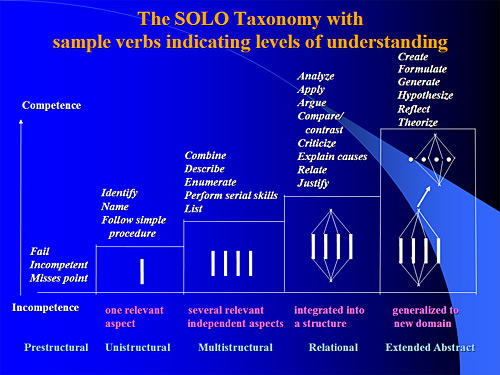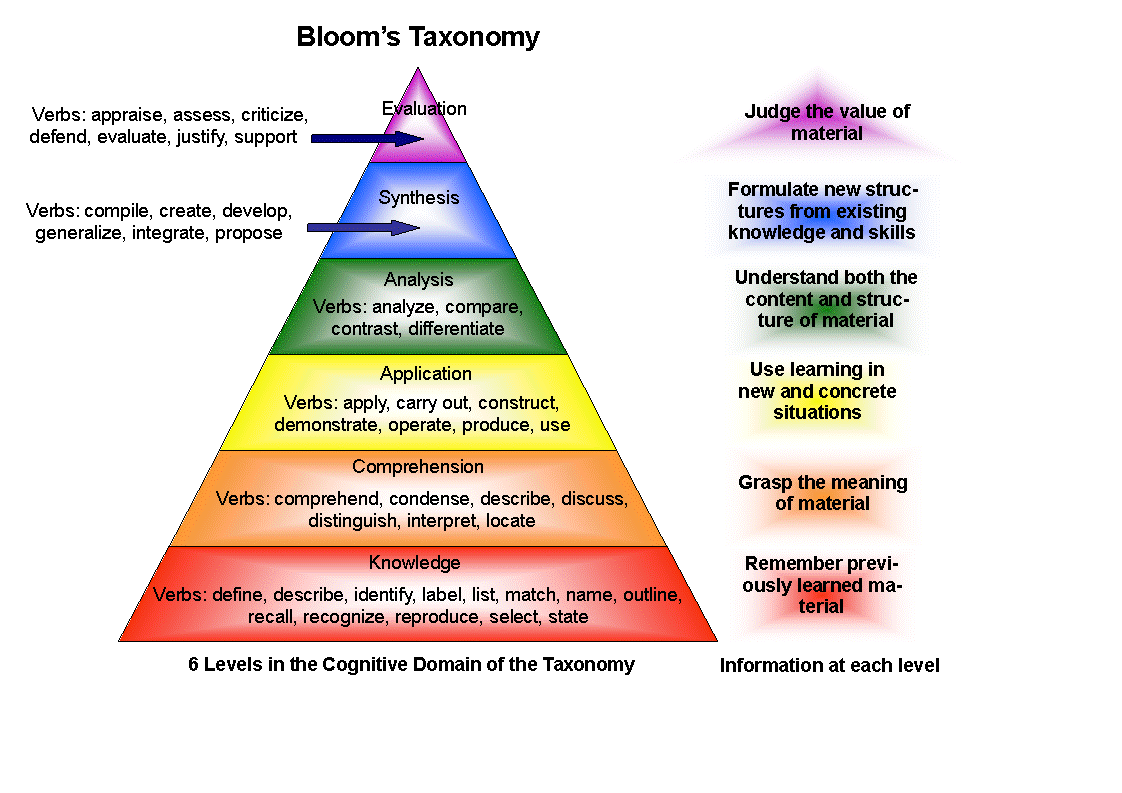Difference between revisions of "OLFM Workshop/Planning/Track 4"
Jump to navigation
Jump to search
| (21 intermediate revisions by 2 users not shown) | |||
| Line 8: | Line 8: | ||
==Encouraging Deeper Approaches to Learning== | ==Encouraging Deeper Approaches to Learning== | ||
| − | Deep: high level cognitive skills used for activities which require them | + | *Deep: high level cognitive skills used for activities which require them |
| − | Surface: low-level cognitive skills for tasks which require high level skills. | + | *Surface: low-level cognitive skills for tasks which require high level skills. |
==Guiding Questions== | ==Guiding Questions== | ||
| Line 22: | Line 22: | ||
*Biggs, J., Kember, D., & Leung, D. Y. P. (2001). The revised two-factor Study Process Questionnaire: R-SPQ-2F. British Journal of Educational Psychology, 71, 133–149. doi:10.1348/000709901158433 | *Biggs, J., Kember, D., & Leung, D. Y. P. (2001). The revised two-factor Study Process Questionnaire: R-SPQ-2F. British Journal of Educational Psychology, 71, 133–149. doi:10.1348/000709901158433 | ||
*Biggs, J., & Collis, K. (1982). Evaluating the quality of learning: The SOLO taxonomy. New York: Academic Press. | *Biggs, J., & Collis, K. (1982). Evaluating the quality of learning: The SOLO taxonomy. New York: Academic Press. | ||
| − | *Madland, C. (2014) Structured Student Interactions in Online Distance Learning: Exploring the study buddy activity. | + | *Madland, C. (2014) [http://bit.ly/1mmcyeG Structured Student Interactions in Online Distance Learning: Exploring the study buddy activity]. Athabasca University |
*Edwards, J (2010) Inviting students to learn: 100 tips for talking effectively with your students.ASCD. Alexandria, Virginia. | *Edwards, J (2010) Inviting students to learn: 100 tips for talking effectively with your students.ASCD. Alexandria, Virginia. | ||
::http://www.ascd.org/publications/books/110015.aspx | ::http://www.ascd.org/publications/books/110015.aspx | ||
==Activities== | ==Activities== | ||
| + | |||
| + | |||
| + | {| class="wikitable" | ||
| + | |- | ||
| + | ! Time !! Topic !! Activity !! Notes | ||
| + | |- | ||
| + | | 9:15 || Welcome and Overview, introductions at tables|| || | ||
| + | |- | ||
| + | | 9:30 || Why is this topic important? || | ||
| + | *student as spectator vs. student engaged in "thinking like a chemist" | ||
| + | *TRU Strategic Priorities || | ||
| + | |- | ||
| + | | 9:45 || Participant perceptions || | ||
| + | discuss at your table | ||
| + | *'What are the characteristics of deep learning vs. surface learning?' | ||
| + | * What would "deep learning" look like in my course? surface learning? | ||
| + | || | ||
| + | |- | ||
| + | | 10:00 || Resources Available || | ||
| + | * Annotated List of Webpages | ||
| + | || | ||
| + | *flip charts | ||
| + | *pens | ||
| + | *guiding questions | ||
| + | |- | ||
| + | | || 3P Model of Teaching and Learning || | ||
| + | || | ||
| + | *flip charts | ||
| + | *pens | ||
| + | *guiding questions | ||
| + | |- | ||
| + | | 10:15 || Constructive Alignment || assessments aligned with outcomes || | ||
| + | |- | ||
| + | | 10:15 || SOLO Taxonomy || assessing deep vs surface approaches || | ||
| + | |} | ||
| + | |||
| + | Guiding questions... | ||
| + | * How can you tell the difference between approaches? | ||
| + | |||
| + | 3P Model | ||
| + | [[File:3P Model of Teaching and Learning.png|thumb|3P Model of Teaching and Learning]] | ||
| + | |||
| + | Group conversations | ||
| + | |||
| + | {| class="wikitable" | ||
| + | |- | ||
| + | ! Time !! Topic !! Activity !! Notes | ||
| + | |- | ||
| + | | 11:00 || Case Studies || || | ||
| + | |- | ||
| + | | 11:15 || Example || || | ||
| + | |- | ||
| + | | 11:30 || Example || Example || | ||
| + | |- | ||
| + | | 11:45 || Example || Example || | ||
| + | |} | ||
| + | |||
| + | {| class="wikitable" | ||
| + | |- | ||
| + | ! Time !! Topic !! Activity !! Notes | ||
| + | |- | ||
| + | | 2:30 || debrief || || | ||
| + | |- | ||
| + | | 2:45 || prepare presentation || || | ||
| + | |- | ||
| + | | 3:00 || wrap up || Example || | ||
| + | |- | ||
| + | | 3:15 || Example || Example || | ||
| + | |} | ||
| + | |||
* [[Teaching and Learning Resources Portal/Distance Technologies|Teaching and Learning Portal]] | * [[Teaching and Learning Resources Portal/Distance Technologies|Teaching and Learning Portal]] | ||
::*The portal is where participants will collaborate and record their learning during the workshop. | ::*The portal is where participants will collaborate and record their learning during the workshop. | ||
| Line 39: | Line 109: | ||
*Example activity: Kanuka's activities as exemplars, then brainstorm activities then peer review, then talk about Study Buddies | *Example activity: Kanuka's activities as exemplars, then brainstorm activities then peer review, then talk about Study Buddies | ||
*Differences between facilitating paced and continuous entry courses | *Differences between facilitating paced and continuous entry courses | ||
| − | |||
| − | |||
| − | |||
| − | |||
| − | |||
Latest revision as of 07:08, 30 May 2014
Facilitators
Mary Wilson, Fränzi Ng, and Colin Madland
Franzi's Foundation Questions
1. How did we arrive at this topic, "Encouraging Deeper Approaches to Learning"? 2. To what extent is this topic based on our interests vs. the needs of OLFMs?
Encouraging Deeper Approaches to Learning
- Deep: high level cognitive skills used for activities which require them
- Surface: low-level cognitive skills for tasks which require high level skills.
Guiding Questions
- What do we mean by a student's approach to learning?
- How are approaches to learning different from learning styles?
- What is the 3-P Model of Teaching and Learning and how is it relevant to TRU-OL?
- What should SMEs and designers consider when planning learning activities?
- What should facilitators consider while the course is in progress?
Resources
- Biggs, J., & Tang, C. (2007). Teaching for quality learning at university: What the student does (3rd ed.). New York: Society for Research into Higher Education & Open University Press. Retrieved from http://site.ebrary.com.ezproxy.tru.ca/lib/trulibrary/docDetail.action
- Biggs, J., Kember, D., & Leung, D. Y. P. (2001). The revised two-factor Study Process Questionnaire: R-SPQ-2F. British Journal of Educational Psychology, 71, 133–149. doi:10.1348/000709901158433
- Biggs, J., & Collis, K. (1982). Evaluating the quality of learning: The SOLO taxonomy. New York: Academic Press.
- Madland, C. (2014) Structured Student Interactions in Online Distance Learning: Exploring the study buddy activity. Athabasca University
- Edwards, J (2010) Inviting students to learn: 100 tips for talking effectively with your students.ASCD. Alexandria, Virginia.
Activities
| Time | Topic | Activity | Notes |
|---|---|---|---|
| 9:15 | Welcome and Overview, introductions at tables | ||
| 9:30 | Why is this topic important? |
| |
| 9:45 | Participant perceptions |
discuss at your table
|
|
| 10:00 | Resources Available |
|
|
| 3P Model of Teaching and Learning |
| ||
| 10:15 | Constructive Alignment | assessments aligned with outcomes | |
| 10:15 | SOLO Taxonomy | assessing deep vs surface approaches |
Guiding questions...
- How can you tell the difference between approaches?
3P Model
Group conversations
| Time | Topic | Activity | Notes |
|---|---|---|---|
| 11:00 | Case Studies | ||
| 11:15 | Example | ||
| 11:30 | Example | Example | |
| 11:45 | Example | Example |
| Time | Topic | Activity | Notes |
|---|---|---|---|
| 2:30 | debrief | ||
| 2:45 | prepare presentation | ||
| 3:00 | wrap up | Example | |
| 3:15 | Example | Example |
- The portal is where participants will collaborate and record their learning during the workshop.
- How might this resource be measured with respect to effectiveness and student learning?
- What activities have been shown to promote deeper approaches? (Kanuka, 2005? Skype Interview?)
- Divide participants by discipline?
- Health
- Business


- Example activity: Kanuka's activities as exemplars, then brainstorm activities then peer review, then talk about Study Buddies
- Differences between facilitating paced and continuous entry courses
